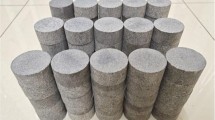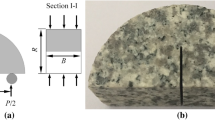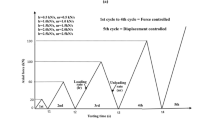Abstract
Tensile properties are one of the most important types of rock properties. Direct tensile tests (DT), Brazilian splitting tests (BT), and uniaxial compression tests (UCTs) were performed to investigate the tensile properties of Beishan granite. The acoustic emission (AE) and deformation were recorded by PCI-2 AE monitoring system and extensometer. The stress–strain characteristics were studied in detail, and the relationships between the strength, strain, and elastic modulus values obtained by the DT and the UCT were respectively analyzed. Crack initiation and propagation during the BT were researched by the spatiotemporal features of AE events, and the results reveal that although a few cracks appeared near the loading points at the beginning of the test, cracks still initiated at the disc center and propagated to the loading points. The b value and AF/RA value were used to study the crack modes of the rock. The results indicate the failure of the specimens during the BT was more severe than that during the DT, and the proportion of rapidly expanding large cracks in the specimens during the BT was higher than that during the DT; the crack modes during the DT were more diverse. Furthermore, a statistical damage constitutive model of Beishan granite was established and verified by the accumulation of AE events. Moreover, the change process of the damage variable D was further divided into three stages, namely the slow increase stage, transition stage, and rapid increase stage.













Similar content being viewed by others
References
Akazawa T (1953) Tension test method for concrete. Int Assoc Test Res Lab Mater Struct 16:13–23
Aliabadian Z, Zhao GF, Russell AR (2019) Failure, crack initiation and the tensile strength of transversely isotropic rock using the Brazilian test. Int J Rock Mech Min Sci 122:104073
Aliha MRM (2014) Indirect tensile test assessments for rock materials using 3-D disc-type specimens. Arab J Geosci 7(11):4757–4766
Andreev GE (1991a) A review of the Brazilian test for rock tensile strength determination. Part I: calculation formula. Min Sci Technol 13(3):445–456
Andreev GE (1991b) A review of the Brazilian test for rock tensile strength determination. Part II: contact conditions. Min Sci Technol 13(3):457–465
Ashtari M, Mousavi SE, Cheshomi A, Khamechian M (2019) Evaluation of the single compressive strength test in estimating uniaxial compressive and Brazilian tensile strengths and elastic modulus of marlstone. Eng Geol 248:256–266
Baykasoğlu A, Güllü H, Çanakçı H, Özbakır L (2008) Prediction of compressive and tensile strength of limestone via genetic programming. Expert Syst Appl 35(1):111–123
Brance WF (1964) Brittle fracture of rocks. In: Judd WR (ed) Proceedings of the International Conference on State of Stress in the Earth’s Crust. Elsevier, New York, 111–174
Cai M, Kaiser P, Martin C (2001) Quantification of rock mass damage in underground excavations from microseismic event monitoring. Int J Rock Mech Min Sci 38(8):1135–1145
Carneiro F, Barcellos A (1953) Resistance a la traction des betons. Bull RILEM I(13):97–108
Cheng JL, Yang SQ, Chen K, Ma D, Li FY, Wang LM (2017) Uniaxial experimental study of the acoustic emission and deformation behavior of composite rock based on 3D digital image correlation (DIC). Acta Mech Sin 33(6):999–1021
Coviello A, Lagioia R, Nova R (2005) On the measurement of the tensile strength of soft rocks. Rock Mech Rock Eng 38(4):251–273
Diederichs MS (2007) The 2003 Canadian geotechnical colloquium: mechanistic interpretation and practical application of damage and spalling prediction criteria for deep tunnelling. Can Geotech J 44(9):1082–1116
Erarslan N, Liang ZZ, Williams DJ (2012) Experimental and numerical studies on determination of indirect tensile strength of rocks. Rock Mech Rock Eng 45(5):739–751
Fairhurst C (1961) Laboratory measurements of some physical properties of rock. In: Proceedings of the fourth symposium on rock mechanics. Pennsylvania, USA, American Rock Mechanics Association
Fairhurst C (1964) On the validity of the ‘Brazilian’ test for brittle materials. Int J Rock Mech Min Sci Geomech Abstr 1(4):535–546
Gerd M (2018) Application of the cluster analysis and time statistic of acoustic emission events from tensile test of a cylindrical rock salt specimen. Eng Fract Mech 210:84–94
Griffith AA (1921) The phenomena of rupture and flow in solids. Philos Trans R Soc Lond 221A:163–198
Guo R, Li S, Zhou D (2016) The three-stage model based on strain strength distribution for the tensile failure process of rock and concrete materials. Acta Mech Solida Sin 2016(05):514–526
Harandizadeh H, Armaghani DJ, Tonnizam E (2020) Development of fuzzy-GMDH model optimized by GSA to predict rock tensile strength based on experimental datasets. Neural Comput Appl 32(17):14047–14067
Hoek E (1964) Fracture of anisotropic rock. J S Afr I Min Mwtall 64(10):501–523
Hoek E, Brown ET (1997) Practical estimates of rock mass strength. Int J Rock Mech Min Sci 34(8):1165–1186
Hudson J, Brown E, Rummel F (1972) The controlled failure of rock discs and rings loaded in diametral compression. Int J Rock Mech Min Sci Geomech Abstr 9(2):241–248
Jin L, Yu WX, Du XL, Yang WG (2020) Meso-scale simulations of size effect on concrete dynamic splitting tensile strength: Influence of aggregate content and maximum aggregate size. Eng Fract Mech 230:106979
Kachanov LM (1985) Time of the rupture process under creep conditions. Izy Akad Nauk SSSR, Otd Tekh Nauk 8:26–31
Karaman K, Kesimal A, Ersoy H (2015) A comparative assessment of indirect methods for estimating the uniaxial compressive and tensile strength of rocks. Arab J Geosci 8(4):2393–2403
Keawsawasvong S, Ukritchon B (2017) Undrained stability of an active planar trapdoor in non-homogeneous clays with a linear increase of strength with depth. Comput Geotech 81:284–293
Klanphumeesri S (2010) Direct tension testing of rock specimens. Masters of Engineering Thesis, Suranaree University of Technology
Li DY, Wong LNY (2013) The Brazilian disk test for rock mechanics applications: review and new insights. Rock Mech Rock Eng 46(2):269–287
Li LC, Tang CA, Zhu WC, Liang ZZ (2009) Numerical analysis of slope stability based on the gravity increase method. Comput Geotech 36(7):1246–1258
Li Q, Zhao GF, Lian JJ (2019) A fundamental investigation of the tensile failure of rock using the three-dimensional lattice spring model. Rock Mech Rock Eng 52(7):2319–1334
Li T, Yang XL (2019) Stability of plane strain tunnel headings in soils with tensile strength cut-off. Tunn Undergr Space Technol 95:103138
Liao ZY, Zhu JB, Tang CA (2019) Numerical investigation of rock tensile strength determined by direct tension, Brazilian and three-point bending tests. Int J Rock Mech Min Sci 115:21–32
Liu LY, Ji HG, Elsworth D, Zhi S, Lv XF, Wang T (2020) Dual-damage constitutive model to define thermal damage in rock. Int J Rock Mech Min Sci 126:104158
Ma W, Wang J, Li X, Wang T (2021) Crack evolution and acoustic emission characteristics of rock specimens containing random joints under uniaxial compression. Acta Geophys 69(6):2427–2441
Mahdiyar A, Armaghani DJ, Marto A, Nilashi M, Ismail S (2019) Rock tensile strength prediction using empirical and soft computing approaches. Bull Eng Geol Environ 78(6):4519–4531
Mellor M, Hawkes I (1971) Measurement of tensile strength by diametral compression of discs and annuli. Eng Geol 5(3):173–225
Myer LR, Kemeny JM, Zheng Z, Suarex R, Ewy RT, Cook NGW (1992) Extensile cracking in porous rock under differential compressive stress. Appl Mech Rev 45(8):263–280
Okubo S, Fukui K (1996) Complete stress-strain curves for various rock types in uniaxial tension. Int J Rock Mech Min Sci 33(6):549–556
Perras MA, Diederichs MS (2014) A review of the tensile strength of rock: concepts and testing. Geol J 32(2):525–546
Phueakphum D, Fuenkajorn K, Walsri C (2013) Effects of intermediate principal stress on tensile strength of rocks. Int J Fract 181(2):163–175
Sha S, Rong G, Peng J, Li B, Wu Z (2019) Effect of open-fire-induced damage on Brazilian tensile strength and microstructure of granite. Rock Mech Rock Eng 52(11):4189–4202
Shang J, West LJ, Hencher SR, Zhao Z (2018) Tensile strength of large-scale incipient rock joints: a laboratory investigation. Acta Geotech 13(4):869–886
Stacey TR (1981) A simple extension strain criterion for fracture of brittle rock. Int J Frac 18:469–474
Stoxreiter T, Gehwolf P, Galler R (2020) Alternative approaches for the determination of unconfined rock deformation and strength properties. Rock Mech Rock Eng 53(1):411–433
Swab JJ, Jian Y, Gamble R, Kilczewski S (2011) Analysis of the diametral compression method for determining the tensile strength of transparent magnesium aluminate spinel. Int J Fract 172(2):187–192
Wei BW, Xu ZK, Liu HZ (2012) Analytic model of creep damage of interfaces for RCCD. Procedia Earth and Planetary Science 5:341–345
Yang SQ, Hu B, Xu P (2019) Study on the damage-softening constitutive model of rock and experimental verification. Acta Mech Sin 35(4):786–798
Yu Y, Yin J, Zhong Z (2006) Shape effects in the Brazilian tensile strength test and a 3D FEM correction. Int J Rock Mech Min Sci 43(4):623–627
Yuan R, Shen B (2017) Numerical modelling of the contact condition of a Brazilian disk test and its influence on the tensile strength of rock. Int J Rock Mech Min Sci 93:54–65
Yuan R, Shi B (2018) Acoustic emission activity in directly tensile test on marble specimens and its tensile damage constitutive model. Int J Coal Sci Technol 5(3):295–304
Zhang Z, Zhang R, Xie H, Liu J, Were P (2015) Differences in the acoustic emission characteristics of rock salt compared with granite and marble during the damage evolution process. Environ Earth Sci 73(11):6987–6999
Funding
This study was financially supported by the NSFC (U20A20266).
Author information
Authors and Affiliations
Corresponding author
Rights and permissions
About this article
Cite this article
Wang, C.S., Liu, J.F., Zhao, Y.W. et al. Mechanical properties and fracture evolution process of Beishan granite under tensile state. Bull Eng Geol Environ 81, 274 (2022). https://doi.org/10.1007/s10064-022-02765-1
Received:
Accepted:
Published:
DOI: https://doi.org/10.1007/s10064-022-02765-1




